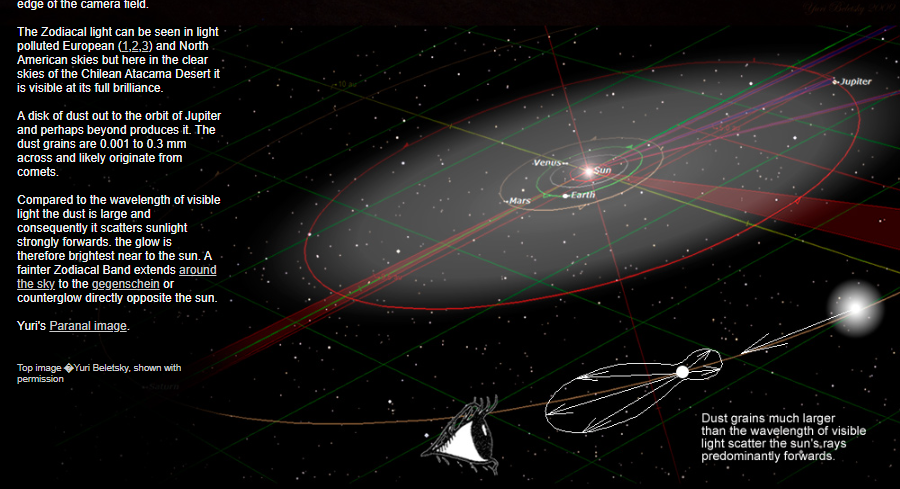Zodiacal Light at La Silla
Zodiacal Light at La Silla: A Spectacular Celestial Phenomenon
Have you ever witnessed a mesmerizing celestial spectacle known as the Zodiacal Light? This ethereal phenomenon, often observed in light-polluted skies of Europe and North America, reveals its full brilliance in the pristine atmosphere of the Chilean Atacama Desert, particularly at the La Silla Observatory. In this article, we will delve into the captivating beauty of the Zodiacal Light and explore the scientific principles behind its formation.
A Glimpse into the Night Sky
Imagine standing beneath the vast expanse of a darkened sky, 80 minutes after sunset, with the sun already 18° below the horizon. As you cast your gaze towards the heavens, a soft, cone-shaped glow emerges, stretching upwards beyond the edge of your vision by an astonishing 40°. This ethereal radiance is the Zodiacal Light, painting the celestial canvas with its subtle luminosity.
Unveiling the Origins
The Zodiacal Light owes its existence to a disk of dust particles that extends from Earth's orbit all the way to the orbit of Jupiter, and possibly even beyond. These minuscule dust grains, ranging in size from 0.001 to 0.3 mm, likely originate from comets that have traversed our solar system over countless millennia.
The Dance of Sunlight and Dust
Despite their diminutive size, these dust grains possess a remarkable ability to scatter sunlight strongly in the forward direction. This scattering phenomenon occurs due to the relatively large size of the dust particles compared to the wavelength of visible light. As a result, the Zodiacal Light glows most intensely near the Sun, gradually diminishing in brightness as it extends away from its radiant source.
The Zodiacal Band and Gegenschein
As the Zodiacal Light encircles the sky, it gives birth to another captivating feature known as the Zodiacal Band. This fainter band of light extends across the heavens, ultimately culminating in the gegenschein, a counterglow directly opposite the Sun. These celestial phenomena form a harmonious symphony of light, captivating stargazers and astronomers alike.
The Enchanting La Silla Observatory
Nestled in the heart of the Chilean Atacama Desert, the La Silla Observatory offers an unparalleled vantage point for observing the Zodiacal Light in all its glory. The crystal-clear skies and minimal light pollution in this remote location provide an optimal environment for capturing the full brilliance of this celestial spectacle.
A Photographer's Delight
Photographers, both amateur and professional, flock to La Silla Observatory to capture breathtaking images of the Zodiacal Light. With its majestic cone shape towering above the horizon, this ethereal phenomenon presents a perfect subject for astrophotography. The resulting images serve as a testament to the sheer beauty and grandeur of our universe.
A Gateway to Deeper Understanding
Beyond its aesthetic appeal, the Zodiacal Light offers scientists a unique opportunity to study the composition and dynamics of interplanetary dust particles. By analyzing the scattered light, researchers can gain valuable insights into the origins of these dust grains and their role in shaping our solar system.
Exploring the Unseen
While the Zodiacal Light is visible to the naked eye, there is much more to discover beyond our limited human perception. Advanced telescopes and instruments at La Silla Observatory enable astronomers to delve deeper into the mysteries of our universe. By studying the Zodiacal Light across different wavelengths and employing sophisticated imaging techniques, scientists can unlock hidden secrets about the nature of interplanetary dust and its influence on our cosmic environment.
A Celestial Symphony
The Zodiacal Light at La Silla Observatory serves as a reminder of the awe-inspiring wonders that await us in the night sky. As we gaze upon this celestial symphony, we are reminded of our place in the vast cosmos and the infinite possibilities that lie beyond. The Zodiacal Light beckons us to explore, to question, and to marvel at the beauty and complexity of our universe.

Zodiacal Light at La Silla
Imaged by Yuri Beletsky from ESO La Silla observatory September 17, '09.
The sun had set 80 minutes previously and was already 18° below the horizon. The red star at low right is Arcturus, the stars of Centaurus are at left.
The ecliptic and the soft cone of the Zodiacal light are nearly vertical. The light extends upwards 40° beyond the edge of the camera field.
The Zodiacal light can be seen in light polluted European (1,2,3) and North American skies but here in the clear skies of the Chilean Atacama Desert it is visible at its full brilliance.
A disk of dust out to the orbit of Jupiter and perhaps beyond produces it. The dust grains are 0.001 to 0.3 mm across and likely originate from comets.
Compared to the wavelength of visible light the dust is large and consequently it scatters sunlight strongly forwards. the glow is therefore brightest near to the sun. A fainter Zodiacal Band extends around the sky to the gegenschein or counterglow directly opposite the sun.
Yuri's Paranal image.
Top image �Yuri Beletsky, shown with permission

Dust grains much larger than the wavelength of visible light scatter the sun's rays predominantly forwards.
Note: this article has been automatically converted from the old site and may not appear as intended. You can find the original article here.
Reference Atmospheric Optics
If you use any of the definitions, information, or data presented on Atmospheric Optics, please copy the link or reference below to properly credit us as the reference source. Thank you!
-
<a href="https://atoptics.co.uk/blog/zodiacal-light-at-la-silla/">Zodiacal Light at La Silla</a>
-
"Zodiacal Light at La Silla". Atmospheric Optics. Accessed on November 26, 2024. https://atoptics.co.uk/blog/zodiacal-light-at-la-silla/.
-
"Zodiacal Light at La Silla". Atmospheric Optics, https://atoptics.co.uk/blog/zodiacal-light-at-la-silla/. Accessed 26 November, 2024
-
Zodiacal Light at La Silla. Atmospheric Optics. Retrieved from https://atoptics.co.uk/blog/zodiacal-light-at-la-silla/.